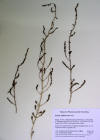|
Suaeda suffruticosa
|
Suaeda nigra |
|
Trees and Shrubs of Kern County (Sep 2012) Suaeda nigra (Chenopodium nigrum Rafinesque 1832) J.F. Macbride 1918 [Includes Suaeda moquinii (Chenopodium moquinii Torrey 1856) Greene 1889; Suaeda torreyana S. Watson 1874; Suaeda ramosissima (Dondia ramosissima Standley 1916) I. M. Johnston 1924, Suaeda suffrutescens S. Watson 1874, not Suaeda fruticosa Forsskål ex J. F.Gmelin 1775 (The Linnaean name, Chenopodium fruticosum = S. vera Forsskål. ex J. F. Gmelin), a Mediterranean species]. Bush seepweed. Shrub or subshrub, or annual (JM2), with reddish wiry stems (in perennial forms) to 1 m or more; leaves needle-like but thick, blunt and fleshy, round or subterete in x-sect., “with a dark green ring just inside epidermis, visible at >= 10× magnification” (JM2), 1–2 cm long, “old leaf scars ± smooth” (JM2); flowering Mar–Sep, flowers green, clustered in axils of upper leaves, “0.4–2 mm diam” (JM2), bisexual, “calyx ± radial, lobes in age generally rounded, hooded or keeled” (JM2), ~1.5 mm, persistent and enclosing the fruit, petals absent; “bracts generally < leaves, generally not overlapping or covering internodes at stem tips” (JM2); Alkaline washes and flats bordering lakes in the deserts below 5,000 ft, also along the coast, north to Canada, east to Texas and south to Mexico. Bush seepweed scrub recognized in MCV2 when dominant and >2% cover. Type from upper part of Canadian River in the Texas Panhandle. Kern Co.: “Common and often abundant over great areas of alkaline plains in the valley and about Koehn Lake on the desert, less common around the dry lakes at Edwards Air Force Base” (Twisselmann), 61–838 m (CCH). The species is regarded as highly variable in habit, leaf thickness and hairiness (JM2). Older floras (e.g., Abrams, Munz & Keck) distinguished additional species and/or varieties by whether they are annuals vs. perennials, by whether leaves are flattened vs. round in x-section, and by whether the plants are hairy vs. not hairy. The names applied were not always correct. The authors in JM2 give a more detailed account in FNA. It is interesting to note that Twisselmann, who listed two species of Suaeda for the Kern County flora, commented under S. torreyana “that the degree of pubescence varies greatly and the segregation of the variety is of dubious merit.” Suaeda nigra was recognized by Abrams as mostly an annual plant. The perennial or shrubby plants might be referred to S. suffrutescens, a name still in wide use today.
|
|



